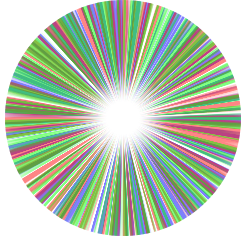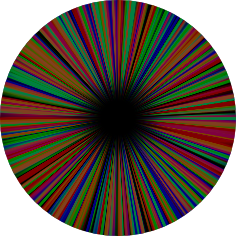I’ve been thinking about how the pupils can be used to communicate emotion. My current plan is to have Alvaro create some unique pupils for each species, and then add a slight tinting overlay to indicate emotion. But such tinting suffers from color combination. All three moods in equal amount add up to grey; that’s not useful. I conclude that the moods must be communicated through individually colored pixels. In other words, each pupil will have some pixels dedicated to red, some dedicated to blue, and some to green. I can then vary the intensity of these to indicate mood.
One approach would be to decompose the image into its red, green, and blue components, adjust the brightness of each component in conformance to the mood, then re-assemble them all into the final result. I fear that this will result only in more greyness, so I’ll have to try it out. Here are a few experiments:


These radial designs suffer from a layering problem: the red layer is on top and blue is on bottom, biasing the image toward the red. That’s unacceptable. If I want to obtain a balance, then I must build the image from multiple layers, alternating each of the colors as I go. But doing so would require lots of drawing operations, and especially rotations, which might require too many GPU cycles. Of course, the thing is running in a tiny space, so perhaps it won’t be slow. Here’s what happens when I use the Java fillArc method:
The differences are subtle but still readable. The algorithm can, I think, be readily be used for animation. But are they congruent with intuition? Is this just some stupid puzzle that people will have to learn to solve?
And how can I differentiate among actors in dream combat using this algorithm? Here are some possible variations:
1. Pupil shape: square, pentagon, hexagon, octagon. Artificial.
2. Shades of white for the eye white.
3. Eye shapes. I doubt that we can go far enough with this and still retain emotional content.
4. Animation styles. flickering radial arcs, rotating radial arcs, dots, spirals, circles.
5. Internal structure: radial arcs, circles, tilted lines, concentric triangles.
I rather like the last two.
